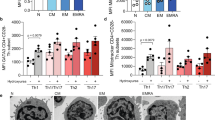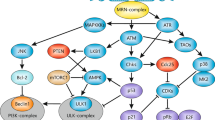Abstract
The cytolytic T lymphocyte protease granzyme A (GzmA) initiates a caspase-independent cell death pathway. Here we report that the rate-limiting enzyme of DNA base excision repair, apurinic endonuclease-1 (Ape1), which is also known as redox factor-1 (Ref-1), binds to GzmA and is contained in the SET complex, a macromolecular complex of 270–420 kDa that is associated with the endoplasmic reticulum and is targeted by GzmA during cell-mediated death. GzmA cleaves Ape1 after Lys31 and destroys its known oxidative repair functions. In so doing, GzmA may block cellular repair and force apoptosis. In support of this, cells with silenced Ape1 expression are more sensitive, whereas cells overexpressing noncleavable Ape1 are more resistant, to GzmA-mediated death.
This is a preview of subscription content, access via your institution
Access options
Subscribe to this journal
Receive 12 print issues and online access
$209.00 per year
only $17.42 per issue
Buy this article
- Purchase on Springer Link
- Instant access to full article PDF
Prices may be subject to local taxes which are calculated during checkout







Similar content being viewed by others
References
Russell, J.H. & Ley, T.J. Lymphocyte-mediated cytotoxicity. Annu. Rev. Immunol. 20, 323–370 (2002).
Beresford, P.J., Xia, Z., Greenberg, A.H. & Lieberman, J. Granzyme A loading induces rapid cytolysis and a novel form of DNA damage independently of caspase activation. Immunity 10, 585–594 (1999).
Shresta, S., Graubert, T.A., Thomas, D.A., Raptis, S.Z. & Ley, T.J. Granzyme A initiates an alternative pathway for granule-mediated apoptosis. Immunity 10, 595–605 (1999).
Fan, Z., Beresford, P.J., Zhang, D. & Lieberman, J. HMG2 Interacts with the nucleosome assembly protein SET and is a target of the cytotoxic T-lymphocyte protease granzyme A. Mol. Cell. Biol. 22, 2810–2820 (2002).
Beresford, P.J., Kam, C.M., Powers, J.C. & Lieberman, J. Recombinant human granzyme A binds to two putative HLA-associated proteins and cleaves one of them. Proc. Natl. Acad. Sci. USA 94, 9285–9290 (1997).
Beresford, P.J. et al. Granzyme A activates an endoplasmic reticulum-associated caspase-independent nuclease to induce single-stranded DNA nicks. J. Biol. Chem. 276, 43285–43293 (2001).
Evans, A.R., Limp-Foster, M. & Kelley, M.R. Going APE over ref-1. Mutat. Res. 461, 83–108 (2000).
Tell, G. et al. An 'environment to nucleus' signaling system operates in B lymphocytes: redox status modulates BSAP/Pax-5 activation through Ref-1 nuclear translocation. Nucleic Acids Res. 28, 1099–1105 (2000).
Bennett, R.A., Wilson, D.M. 3rd, Wong, D. & Demple, B. Interaction of human apurinic endonuclease and DNA polymerase β in the base excision repair pathway. Proc. Natl. Acad. Sci. USA 94, 7166–7169 (1997).
Nakamura, J. & Swenberg, J.A. Endogenous apurinic/apyrimidinic sites in genomic DNA of mammalian tissues. Cancer Res. 59, 2522–2526 (1999).
Xanthoudakis, S. & Curran, T. Identification and characterization of Ref-1, a nuclear protein that facilitates AP-1 DNA-binding activity. EMBO J. 11, 653–665 (1992).
Hirota, K. et al. AP-1 transcriptional activity is regulated by a direct association between thioredoxin and Ref-1. Proc. Natl. Acad. Sci. USA 94, 3633–3638 (1997).
Gaiddon, C., Moorthy, N.C. & Prives, C. Ref-1 regulates the transactivation and pro-apoptotic functions of p53 in vivo. EMBO J. 18, 5609–5621 (1999).
Zhang, D. et al. Induction of rapid histone degradation by the cytotoxic T lymphocyte protease granzyme A. J. Biol. Chem. 276, 3683–3690 (2001).
Zhang, D., Beresford, P.J., Greenberg, A.H. & Lieberman, J. Granzymes A and B directly cleave lamins and disrupt the nuclear lamina during granule-mediated cytolysis. Proc. Natl. Acad. Sci. USA 98, 5746–5751 (2001).
Masuda, Y., Bennett, R.A. & Demple, B. Dynamics of the interaction of human apurinic endonuclease (Ape1) with its substrate and product. J. Biol. Chem. 273, 30352–30359 (1998).
Elbashir, S.M. et al. Duplexes of 21-nucleotide RNAs mediate RNA interference in cultured mammalian cells. Nature 411, 494–498 (2001).
Rothwell, D.G. et al. Substitution of Asp-210 in HAP1 (APE/Ref-1) eliminates endonuclease activity but stabilises substrate binding. Nucleic Acids Res. 28, 2207–2213 (2000).
Xanthoudakis, S., Miao, G.G. & Curran, T. The redox and DNA-repair activities of Ref-1 are encoded by nonoverlapping domains. Proc. Natl. Acad. Sci. USA 91, 23–27 (1994).
Walker, L.J., Robson, C.N., Black, E., Gillespie, D. & Hickson, I.D. Identification of residues in the human DNA repair enzyme HAP1 (Ref-1) that are essential for redox regulation of Jun DNA binding. Mol. Cell. Biol. 13, 5370–5376 (1993).
Wilson, D.M. 3rd & Barsky, D. The major human abasic endonuclease: formation, consequences and repair of abasic lesions in DNA. Mutat. Res. 485, 283–307 (2001).
Mitra, S. et al. Complexities of DNA base excision repair in mammalian cells. Mol. Cell 7, 305–312 (1997).
Ramana, C.V., Boldogh, I., Izumi, T. & Mitra, S. Activation of apurinic/apyrimidinic endonuclease in human cells by reactive oxygen species and its correlation with their adaptive response to genotoxicity of free radicals. Proc. Natl. Acad. Sci. USA 95, 5061–5066 (1998).
Tewari, M. et al. Yama/CPP32β, a mammalian homolog of CED-3, is a CrmA-inhibitable protease that cleaves the death substrate poly(ADP-ribose) polymerase. Cell 81, 801–809 (1995).
Oliver, F.J. et al. Importance of poly(ADP-ribose) polymerase and its cleavage in apoptosis. Lesson from an uncleavable mutant. J. Biol. Chem. 273, 33533–33539 (1998).
Hansen, W.K. et al. Creation of a fully functional human chimeric DNA repair protein. Combining O6-methylguanine DNA methyltransferase (MGMT) and AP endonuclease (APE/redox effector factor 1 (Ref 1)) DNA repair proteins. J. Biol. Chem. 273, 756–762 (1998).
Prieto-Alamo, M.J. & Laval, F. Overexpression of the human HAP1 protein sensitizes cells to the lethal effect of bioreductive drugs. Carcinogenesis 20, 415–419 (1999).
Hall, J.L., Wang, X., Van, A., Zhao, Y. & Gibbons, G.H. Overexpression of ref-1 inhibits hypoxia and tumor necrosis factor- induced endothelial cell apoptosis through nuclear factor-κB-independent and -dependent pathways. Circ. Res. 88, 1247–1253 (2001).
Robertson, K.A. et al. Altered expression of Ape1/ref-1 in germ cell tumors and overexpression in NT2 cells confers resistance to bleomycin and radiation. Cancer Res. 61, 2220–2225 (2001).
Kakolyris, S. et al. Human apurinic endonuclease 1 expression in a colorectal adenoma-carcinoma sequence. Cancer Res. 57, 1794–1797 (1997).
Moore, D.H., Michael, H., Tritt, R., Parsons, S.H. & Kelley, M.R. Alterations in the expression of the DNA repair/redox enzyme APE/ref-1 in epithelial ovarian cancers. Clin. Cancer Res. 6, 602–609 (2000).
Robertson, K.A. et al. Down-regulation of apurinic/apyrimidinic endonuclease expression is associated with the induction of apoptosis in differentiating myeloid leukemia cells. Cell Growth Differ. 8, 443–449 (1997).
Duguid, J.R., Eble, J.N., Wilson, T.M. & Kelley, M.R. Differential cellular and subcellular expression of the human multifunctional apurinic/apyrimidinic endonuclease (APE/ref-1) DNA repair enzyme. Cancer Res. 55, 6097–6102 (1995).
Bai, J., Brody, J.R., Kadkol, S.S. & Pasternack, G.R. Tumor suppression and potentiation by manipulation of pp32 expression. Oncogene 20, 2153–2160 (2001).
Shikama, N. et al. Functional interaction between nucleosome assembly proteins and p300/CREB-binding protein family coactivators. Mol. Cell. Biol. 20, 8933–8943 (2000).
Seo, S. et al. Regulation of histone acetylation and transcription by INHAT, a human cellular complex containing the SET oncoprotein. Cell 104, 119–130 (2001).
Seo, S.B. et al. Regulation of histone acetylation and transcription by nuclear protein pp32, a subunit of the INHAT complex. J. Biol. Chem. 277, 14005–14010 (2002).
Cervoni, N., Detich, N., Seo, S.B., Chakravarti, D. & Szyf, M. The oncoprotein Set/TAF-1β, an inhibitor of histone acetyltransferase, inhibits active demethylation of DNA, integrating DNA methylation and transcriptional silencing. J. Biol. Chem. 277, 25026–25031 (2002).
Adachi, Y., Pavlakis, G.N. & Copeland, T.D. Identification of in vivo phosphorylation sites of SET, a nuclear phosphoprotein encoded by the translocation breakpoint in acute undifferentiated leukemia. FEBS Lett. 340, 231–235 (1994).
Nagata, K. et al. Cellular localization and expression of template-activating factor I in different cell types. Exp. Cell. Res. 240, 274–281 (1998).
Xia, Z. et al. Expression and purification of enzymatically active recombinant granzyme B in a baculovirus system. Biochem. Biophys. Res. Commun. 243, 384–389 (1998).
Shi, L., Kraut, R.P., Aebersold, R. & Greenberg, A.H. A natural killer cell granule protein that induces DNA fragmentation and apoptosis. J. Exp. Med. 175, 553–566 (1992).
Fritz, G. & Kaina, B. Phosphorylation of the DNA repair protein APE/REF-1 by CKII affects redox regulation of AP-1. Oncogene 18, 1033–1040 (1999).
Acknowledgements
We thank M. Russo for technical support; B. Demple, D. Oh, X.-F. Yang, L. Shi and K. Kaznatcheev for suggestions; and the National Center for Cell Culture for preparing K562 cell lysates to purify the SET complex. This work was supported by a grant from the National Institutes of Health (NIH) to J.L. and the NIH-supported Dana Farber Cancer Institute, Beth Israel Deaconess Medical Center and Children's Hospital Center for AIDS Research.
Author information
Authors and Affiliations
Corresponding author
Ethics declarations
Competing interests
The authors declare no competing financial interests.
Rights and permissions
About this article
Cite this article
Fan, Z., Beresford, P., Zhang, D. et al. Cleaving the oxidative repair protein Ape1 enhances cell death mediated by granzyme A. Nat Immunol 4, 145–153 (2003). https://doi.org/10.1038/ni885
Received:
Accepted:
Published:
Issue Date:
DOI: https://doi.org/10.1038/ni885
This article is cited by
-
Ref-1 redox activity alters cancer cell metabolism in pancreatic cancer: exploiting this novel finding as a potential target
Journal of Experimental & Clinical Cancer Research (2021)
-
APE1 distinguishes DNA substrates in exonucleolytic cleavage by induced space-filling
Nature Communications (2021)
-
Anti-inflammatory activity of extensively hydrolyzed casein is mediated by granzyme B
Inflammation Research (2019)
-
DNA repair protein APE1 is involved in host response during pneumococcal meningitis and its expression can be modulated by vitamin B6
Journal of Neuroinflammation (2017)
-
Regulation of SET Gene Expression by NFkB
Molecular Neurobiology (2017)



